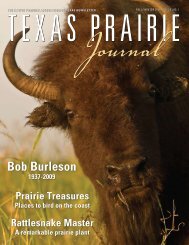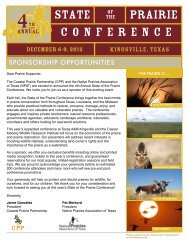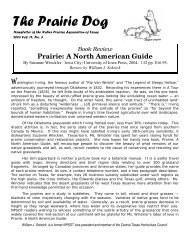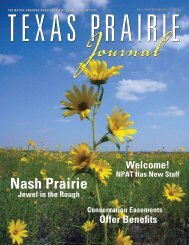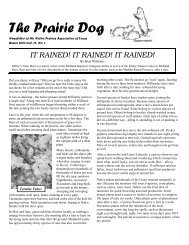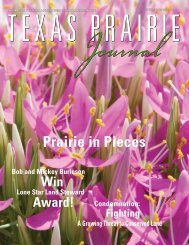2007 Fall/Winter issue - Native Prairies Association of Texas
2007 Fall/Winter issue - Native Prairies Association of Texas
2007 Fall/Winter issue - Native Prairies Association of Texas
You also want an ePaper? Increase the reach of your titles
YUMPU automatically turns print PDFs into web optimized ePapers that Google loves.
New Conservation Easement Donations<br />
Senate version <strong>of</strong> the Farm Bill would make the provisions permanent<br />
In 2006 Congress passed the Pension<br />
Protection Act <strong>of</strong> 2006 that, among<br />
other provisions, includes bold<br />
new tax incentives for land conservation<br />
easement donations. The changes –<br />
effective until December 31, <strong>2007</strong> – were<br />
signed into law by President Bush on<br />
August 17, 2006. This new law presents a<br />
limited-time opportunity for landowners<br />
who may be considering making a<br />
donation for conservation purposes.<br />
[Update: The Senate version <strong>of</strong> the Farm<br />
Bill would make the provisions permanent.<br />
The Land Trust Alliance worked hard<br />
towards this goal, and we hope the bill<br />
created by the House/Senate conference<br />
will contain the provision. For more info,<br />
visit: www.wumple.com/p=90.]<br />
These new benefits will help protect your<br />
land and rural livelihood forever.<br />
If you or your client own land with<br />
important natural or historic resources,<br />
donating a voluntary conservation<br />
agreement can be one <strong>of</strong> the smartest ways<br />
to conserve the land you love, protect<br />
America’s natural heritage, maintain<br />
your private property rights and realize<br />
significant federal tax benefits.<br />
These new incentives are the boldest<br />
change to conservation tax law in two<br />
decades. They allow modest income landowners,<br />
like working family farmers<br />
and ranchers, to deduct much more than<br />
they could under the old rules, bringing<br />
increased fairness to the tax code. While<br />
the new provisions are set to expire in<br />
December <strong>of</strong> <strong>2007</strong>, the coalition behind<br />
these incentives is working to make them<br />
permanent. Unfortunately, there is no<br />
guarantee they will be available in 2008 or<br />
beyond. Now is the time to consider using<br />
them in your personal tax and<br />
estate planning.<br />
Among the changes, the new law:<br />
1. Raises the deduction a landowner can<br />
take for donating a conservation easement<br />
from 30% <strong>of</strong> their adjusted gross income in<br />
any year to 50%;<br />
2. Allows qualifying farmer, ranchers and<br />
forest landowners to deduct up to 100% <strong>of</strong><br />
their taxable income (e.g., pay no federal<br />
income tax); and<br />
3. Extends the carry-forward period<br />
for a donor to take tax deductions for a<br />
conservation easement from 5 to 15 years.<br />
How does it work<br />
Before the rule change, it was very<br />
difficult for someone with limited income<br />
to donate a conservation easement because<br />
<strong>of</strong> the way the federal tax code was<br />
structured. The new rules allow more<br />
moderate-income landowners to participate<br />
directly in land conservation, especially<br />
farmers whose income may be very<br />
limited compared to the increasing value<br />
<strong>of</strong> their property. Take the following<br />
hypothetical example:<br />
Photo Courtesy <strong>of</strong> Lisa spangler<br />
Mr. Brown owns 50 acres <strong>of</strong> land with<br />
environmental conservation value that he<br />
wants to protect forever. Mr. Brown’s annual<br />
taxable income is $100,000. He wants to<br />
donate his property’s development rights to a<br />
land trust through a conservation easement.<br />
The donation is valued at $70 1/20,000.<br />
Under the Old Law<br />
Mr. Brown is only allowed to deduct<br />
30% <strong>of</strong> his taxable income and only has 6<br />
years total to use up the deduction:<br />
Total value <strong>of</strong> the gift= $70 1/20,000<br />
Mr. Brown’s annual tax deduction =$30,000<br />
(30% <strong>of</strong> his $100,000 taxable income)<br />
Eligible time period = 6 years (year <strong>of</strong><br />
the gift + 5-year carry-forward)<br />
Tax deduction claimed = $180,000<br />
($30,000/year x 6 years).<br />
Tax deduction lost = $520,000 ($70<br />
1/20,000 value - $180,000 deduction)<br />
Based on these numbers, Mr. Brown’s financial<br />
consultant advises him against do nating<br />
the development rights and the property<br />
is ultimately sold for a new subdivision.<br />
Under the New Law<br />
Mr. Brown is allowed to deduct 50% <strong>of</strong><br />
his taxable income and has 16 years to use<br />
up the deduction:<br />
Total value <strong>of</strong> gift = $70 1/20,000<br />
Mr. Brown’s annual tax deduction =<br />
$50,000 (50% <strong>of</strong> his $100,000 taxable<br />
income)<br />
Eligible time period = 16 years (year <strong>of</strong><br />
the gift + 15-year carry-forward)<br />
Tax deduction claimed = $70 1/20,000<br />
($50,000/year over first 14 years).<br />
Tax deduction lost = $0 ($70 1/20,000<br />
value - $70 1/20,000 deduction)<br />
Based on these numbers, Mr. Brown’s<br />
financial consultant advises him to donate<br />
the development rights and the property is<br />
conserved forever.<br />
And it could get even better … If Mr.<br />
Brown were a family farmer or rancher and<br />
wanted to preserve his farm, his deduction<br />
would increase from 50% to 100% <strong>of</strong> his<br />
annual taxable income!<br />
Is a conservation easement right<br />
for you or your client<br />
A landowner should always get pr<strong>of</strong>essional<br />
financial planning and legal advice<br />
before making such a major donation. Here<br />
is what you need to know and consider:<br />
• A voluntary conservation agreement,<br />
also known as a conservation easement,<br />
is a legal agreement between a landowner<br />
and a nonpr<strong>of</strong>it land trust or government<br />
agency that permanently limits uses <strong>of</strong><br />
the land in order to protect important<br />
conservation values. It allows you to<br />
continue to own and use your land and to<br />
sell it or pass it on to heirs.<br />
• When you enter into a voluntary<br />
conservation agreement with a land trust,<br />
you give up some <strong>of</strong> the rights associated<br />
with the land. For example, you might give<br />
up the right to subdivide your land or build<br />
additional houses, while retaining the full<br />
right to grow crops. Future owners will<br />
be bound by the agreement’s terms. The<br />
land trust which holds title to the easement<br />
is responsible for (continlued on page 9)<br />
6 <strong>Native</strong> <strong>Prairies</strong> <strong>Association</strong> <strong>of</strong> <strong>Texas</strong> TEXAS PRAIRIE Journal



